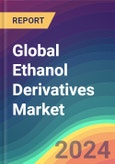The global Ethanol Derivatives market has expanded to reach approximately 4200 thousand tonnes in 2021 and is expected to grow at an impressive CAGR of 5.23% during the forecast period until 2030. High demand for ethanol derivatives as it is used as a cleaning agent and as a solvent is the major driver for the forecast period.In 2019, the Global Ethanol Derivatives Demand Rose to 4.4 Million Tonnes and the Market is Estimated to Grow at a Healthy CAGR of 5.36% During the Period Between 2021-2030.
Ethanol can be produced from the fermentation process of an organic substance as well as by Ethylene under the influence of a catalyst for industrial purposes. Ethanol Derivatives are a vast market comprising a number of chemical products filtered in different categories as per their applications and properties. Some of the major ethanol derivatives are ethyl acetate, ethyl esters, ethylene, ethyl chloride, ethyl bromide, diethyl ether, and acetaldehyde. With the increasing number of facilities for the production of Ethanol on the back of its high demand as a renewable fuel and cleaning agent, Ethanol derivatives have gained huge preference owing to the affordable prices and eco-friendly product in comparison to several crude derivatives. Ethanol derivatives are utilized in chemical, pharmaceutical, food, and beverages industries to produce a wide number of downstream products.
Utilization and growing demand for bio-based ethanol derivatives can be a major potential segment for the growth of the global Ethanol market in the coming years. Additionally, in the forecast period, the usage of these derivatives to manufacture Paints, Coatings & Adhesives is anticipated to play a significant role in the growth of Ethanol Derivatives owing to construction and industrialization on a global level. Due to their expanding use in numerous important end-use industries, including medicines, food and beverage manufacturing, and perfumes, ethyl acetate's demand as a solvent is rising globally. The global Ethanol Derivatives market is anticipated to reach 7000 thousand tonnes by 2030.
The Asia Pacific region dominates the Ethanol Derivatives market based on demand by region. Asia's leading nations, including India, China, Japan, Thailand, and others, are leading the world in paints, coatings, and adhesives. Due to the increasing population and rising construction activity in the residential and institutional sectors, Asia's demand for Ethanol Derivatives is anticipated to rise in the upcoming years. Additionally, ethyl acetate is in high demand from the pharmaceutical and cosmetic industries in western countries and is expected to grow in the coming years. Due to the abundance of feedstock availability to produce ethanol derivatives, China is leading as the producer of these derivatives.
Based on the end-user industry, the global Ethanol Derivatives market is segregated into Paints, Coatings & Adhesives, Personal Care and Cosmetics, Pharmaceutical, and Other end-use industries. Ethanol Derivatives are primarily consumed in the Paints, Coatings & Adhesives industry. In 2021, this industry accounted for approximately 50% of the global market. Ethyl Acetate, one of the leading derivatives of ethanol, is used in the formulae of coatings, including acrylics, enamel paints, and urethanes. These derivatives are widely employed in manufacturing paints, coatings, and adhesives. The growing industrialization is anticipated to further increase the demand for Paints, Coatings & Adhesives in the forecast period.
Major players in the production of Global Ethanol Derivatives are Celanese Corporation, Jiangmen Handsome, Jiangsu Jinmaoyuan, India Glycols Limited, Jubliant Lifesciences, Jiangu Sopo, Laxmi Organic Industies Ltd, Anhui Huayi, and Braskem.
Years considered for this report:
- Historical Period: 2015- 2021
- Base Year: 2021
- Estimated Year: 2022
- Forecast Period: 2023-2030
Objective of the Study:
- To assess the demand-supply scenario of Ethanol Derivatives which covers production, demand and supply of Ethanol Derivatives market in the globe.
- To analyse and forecast the market size of Ethanol Derivatives
- To classify and forecast Global Ethanol Derivatives market based on end-use and regional distribution.
- To examine competitive developments such as expansions, mergers & acquisitions, etc., of Ethanol Derivatives market in the globe.
The publisher calculated Ethanol Derivatives demand in the globe by analyzing the historical data and demand forecast which was carried out considering the historical extraction and supply and demand of Ethanol Derivatives across the globe. The publisher sourced these values from industry experts, and company representatives and externally validated through analyzing historical sales data of respective manufacturers to arrive at the overall market size. Various secondary sources such as company websites, association reports, annual reports, etc., were also studied by the publisher.
Key Target Audience:
- Ethanol Derivatives manufacturers and other stakeholders
- Organizations, forums and alliances related to Ethanol Derivatives distribution
- Government bodies such as regulating authorities and policy makers
- Market research organizations and consulting companies
Report Scope:
In this report, Global Ethanol Derivatives market has been segmented into following categories, in addition to the industry trends which have also been detailed below:- Market, by End-use: Paints, Coatings & Adhesives, Personal Care and Cosmetics, Pharmaceutical, and Other
- Market, by Sales Channel: Direct Sale and Indirect Sale
- Market, by Region: North America, Europe, Asia Pacific, Middle East and Africa, and South America.








